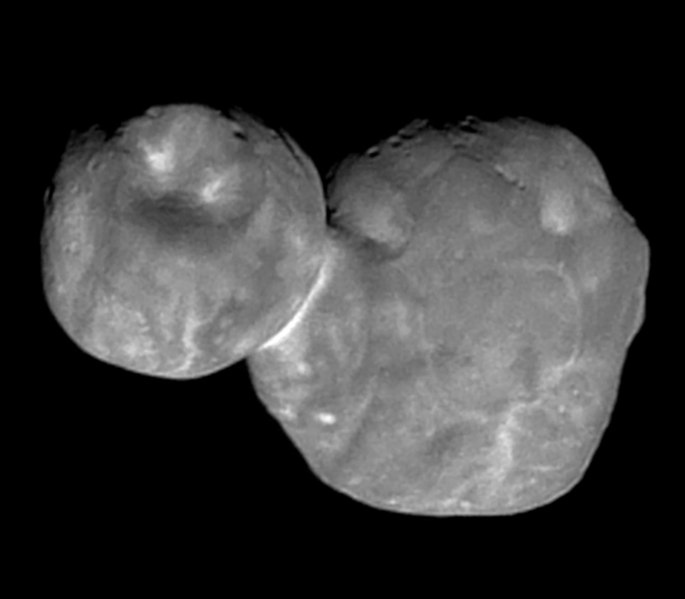
Data collected from the New Horizons space probe’s 2019 flyby of a snowman-shaped object at the edge of the solar system has settled a debate about how the early solar system formed.
Previously, there had been two prevailing theories regarding how this happened: either the matter in the proto-planetary disk smashed together violently—eventually forming the Sun, planets and other bodies within the system—or the matter involved clumped together in a much more gentle fashion. The data gathered by New Horizons of Arrokoth, an object 6.7 billion kilometers (4.2 billion miles) from the Sun that appears to have remained well preserved since the solar system‘s formation nearly 4.6 billion years ago, appears to have settled that debate.
“There was the prevailing theory from the late 1960s of violent collisions and a more recent emerging theory of gentle accumulation,” explains Dr Alan Stern, the principal investigator of the New Horizons mission. “One is dust and the other is the only one standing. This rarely happens in planetary science, but today we have settled the matter.”
Arrokoth, formerly called Ultima Thule, is a celestial body called a contact binary, a single entity formed from two smaller objects that wound up in an orbit so close that they eventually came to settle on one another, resulting in Arrokoth’s distinctive snowman-like shape.
Arrokoth’s larger lobe appears to have formed from eight or more smaller objects that fused together before the 21 kilometer (13 mile) object connected with its smaller (15 kilometer/9 mile-wide) companion. Both lobes show no evidence of a violent impact, showing no stress fractures or flattening, indicating that the two components came into contact gently.
“It is nice to have this evidence because the crashing together theory was a nice theory, but there were some challenges to it,” according to Dr Maggie Aderin-Pocock, co-host of the BBC’s Sky at Night program. “Why did the objects stick together and not bounce apart. There was a lot that didn’t add up.”
Arrokoth is a Powhatan/Algonquian word that is thought to have meant “sky”; unfortunately, the exact meaning and pronunciation of the word remains unknown, as the Powhatan language went extinct in the late 18th century. Arrokoth’s earlier nickname—Ultima Thule, Latin for “farthest Thule”—was meant to allude to the most distant place beyond the borders of the known world. However, the name generated controversy because of its use by Nazi occultists as the supposed mythical origin of the Aryan race.
Subscribers, to watch the subscriber version of the video, first log in then click on Dreamland Subscriber-Only Video Podcast link.
So they ‘fused’ while still hot?
Arrokoth’s composition is estimated to be similar to that of a typical comet—the quintessential “dirty snowball”—so if its components had undergone a hot period, it would have cooled before they had merged, otherwise it’d be more spherical in shape.
Basically, there’s an upper limit to how dense the object can be, otherwise the “neck” would have collapsed long ago from the gravitational pull between the two lobes, meaning that it’s probably made of comet-stuff.
So, what if this object is the result of larger objects that had collided, and the resultant ejecta, some of which is now moving in the same direction and at a speed slow enough to not splatter when the smaller objects met but still hot enough to fuse?
Just a thought.
Although that’s not a bad idea, see my answer to Annaboo’s question above: since they’re mostly water, any hot phase would have caused them to form a more spherical shape. Additionally, if they were composed of a more asteroid-like rock/metal makeup, the 8+ individual components that make up Ultima’s mass wouldn’t be nearly as apparent as they are, if they were to be visible at all.
There appear to be craters near the terminators of both fused bodies. Doesn’t this imply greater solidity than “dirty snow”? Also, unlike the barely-fused balls of the two large objects, the smaller component bodies of the larger ball appear thoroughly compacted, implying different conditions at the time of their impaction.
Craters can still be dug into low-density material, it just means that whatever hit it didn’t hit it hard enough to blow the structure itself apart. In fact, it’s much easier to blow a crater into a low-density medium: throwing a snowball—or a rock, for that matter—into a snowdrift doesn’t obliterate the drift, but the force needed to blow a hole in a boulder with something might blow the boulder apart.
However, you’re right in that Arrokoth’s density is higher than that of snow: although use of the analogy “dirty snowball” has become commonplace for describing comets and the like, they’re really made of dirty ice.
The conditions present when Ultima’s components came together were obviously different than when it contacted Thule, since the two events presumably would have taken place in very different eras. But in that context the melding that appears to have taken place could simply be attributed to just that: time. Remember, this is basically a very slow-moving fluid, a 21 kilometer (13 mile)-wide glacier that despite being somewhat more dense than the ice we’re used to will slowly try to form itself into a sphere given enough time.
One thing I didn’t think to point out earlier is that the Ultima lobe isn’t a sphere, but is actually a disk, something that doesn’t show up well in the New Horizons flyby images, due to the probe viewing the lobe face-on.